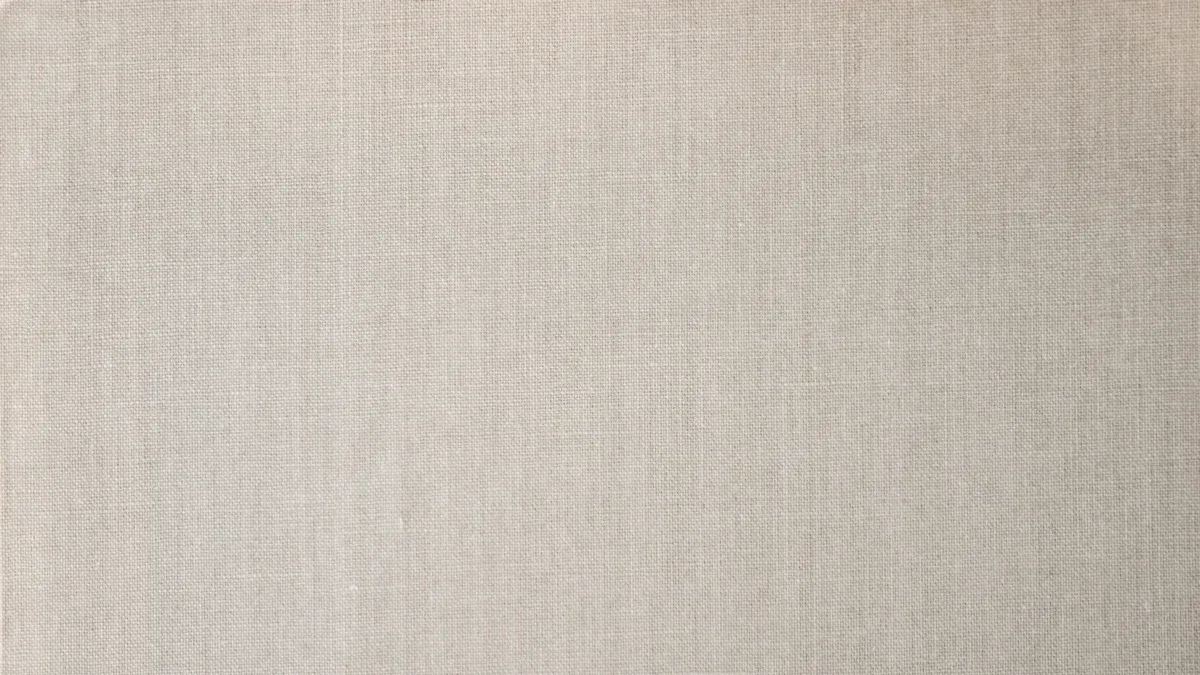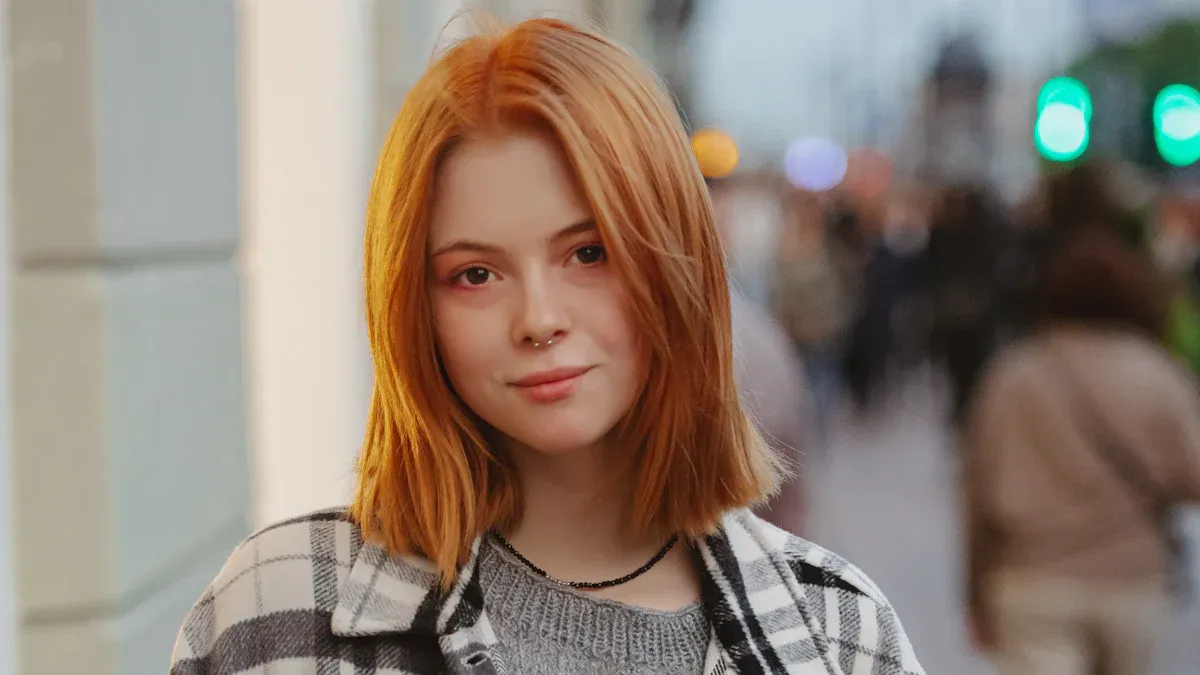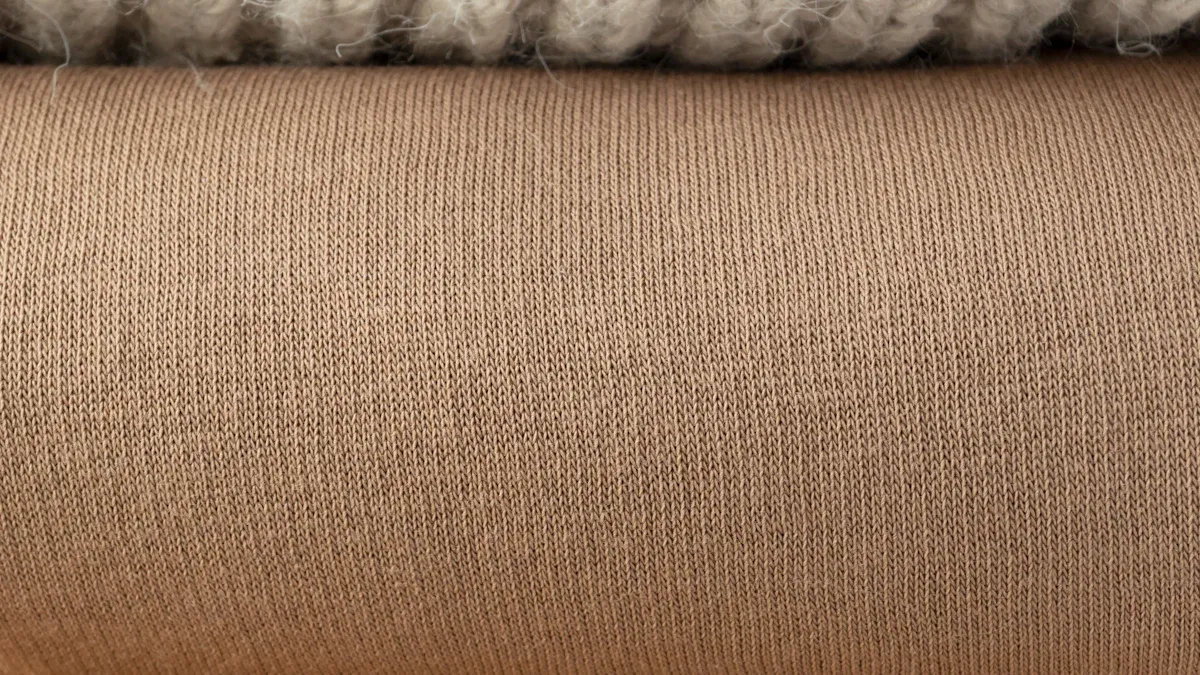
Imagine you are shopping for a new sweater or sportswear. You see many different fabrics on the wall. To pick the right rib knit fabric, think about how you want your clothes to feel. Think about how you want them to work for you. Many people want their clothes to be soft and stretchy. They also want them to let air in, especially for comfort or if they have sensitive skin. Rib knit fabric is good for activewear and casual clothes. It can stretch well and keep its shape. If you want clothes that are easy to wash or last longer, blends or synthetics might be better for you.
Key Takeaways
- Rib knit fabric can stretch a lot. It feels soft on your skin. It keeps its shape well. This makes it good for comfy and active clothes.
- There are many rib knit types like cotton, polyester, rayon, wool, and bamboo. Each type has special benefits. Some let air in better. Some last longer. Some keep you warm. Some are better for the planet.
- Pick the rib knit fabric weight and rib pattern for your clothing. This helps you get the right fit, stretch, and style.
- Take care of rib knit clothes by washing them in cold water. Lay them flat to dry. Do not use heat. This helps them last longer.
- Rib knit fabrics with spandex blends can stretch even more. They go back to their shape fast. These are great for sportswear and tight clothes.
What Is Ribbed Knit fabric
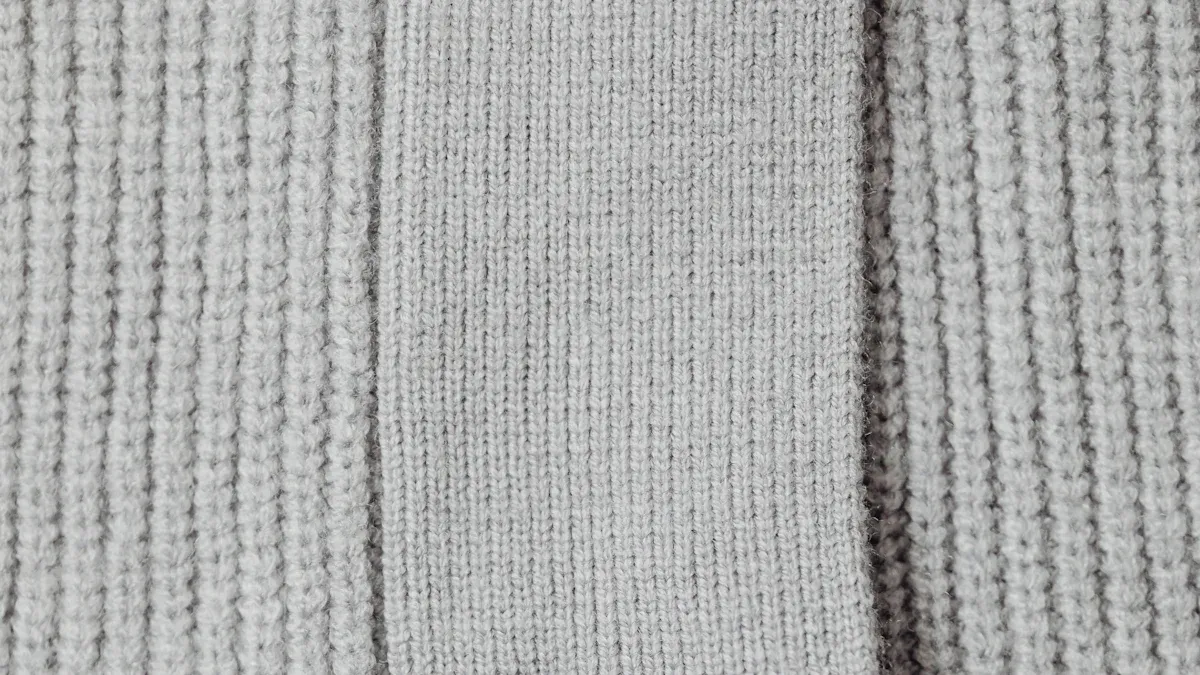
When you look at rib knit fabric, you notice its unique texture right away. This fabric stands out because of the way it is made. You see vertical lines, or ribs, running up and down on both sides. These ribs come from a special knitting method that uses both knit and purl stitches in an alternating pattern. This gives rib knit fabric its signature look and feel.
- Rib knit fabric has vertical ribs on both sides.
- The fabric stretches easily in both directions.
- Both sides look almost the same, so you can use either side as the front.
- You find different rib patterns, such as 1×1, 2×1, or 2×2, which describe the number of knit and purl stitches in each row.
- Some rib knits include Lycra, which adds even more stretch and helps the fabric keep its shape.
Tip: If you want a fabric that hugs your body and bounces back after stretching, rib knit fabric is a great choice.
You might wonder how rib knit fabric compares to other knits. The table below shows the main differences:
| Knit Fabric Type | Structure Description | Key Characteristics |
|---|---|---|
| Rib Knit | Alternating knit and purl stitches create vertical ribs on both sides | Excellent stretch in both directions; soft, flexible, and reversible |
| Jersey Knit | Single-knit with a smooth front and textured back | Lightweight; less stretch; edges curl easily |
| Interlock Knit | Double-knit made from two layers of rib knit | Thicker, stable, reversible; edges do not curl |
Rib knit fabric works well for snug clothing, neckbands, and cuffs. You get a fabric that feels soft, stretches with your movements, and keeps its shape over time. This makes it a popular choice for many types of clothing.
Benefits of Using Rib Knit for Clothing
Comfort and Stretch
When you choose rib knit fabric, you get clothing that feels soft and moves with you. The benefits of using rib knit for clothing start with comfort. Rib knit fabric stretches easily, so your clothes fit well and do not feel tight. Scientific tests show that rib knit fabrics, like 2×1 and 2×2 rib stitches, have excellent stretch and recovery. This means your shirt or sweater can stretch up to twice its width and still return to its original shape. You will notice this when you bend, reach, or play sports.
Rib knit fabric is also very breathable. It lets air flow through, which keeps you cool. In consumer wear trials, people say rib knit feels more comfortable than other knits because it is breathable and moisture-wicking. You stay dry and fresh, even if you sweat. If you pick a rib knit with spandex or modal, you get even more stretch and recovery, plus a soft touch. These blends make the fabric more moisture-wicking and breathable, perfect for activewear or everyday clothes.
Tip: If you want a breathable fabric that keeps you dry and moves with your body, rib knit is a smart choice.
Durability and Shape Retention
Rib knit fabric is not just comfortable; it is also durable. You can wash and wear rib knit clothes many times, and they still look good. Market research shows that polyester rib knit, especially with spandex, keeps its shape and color after 15 washes, with less than 1% shrinkage. The fabric resists pilling and fading, so your clothes stay new-looking longer.
The ribbed structure gives the fabric strong stretch and recovery. This helps your clothes keep their fit, even after lots of use. Rib knit fabrics also pass tough abrasion tests, surviving over 100,000 cycles in some cases. This means your rib knit clothes can handle daily wear and tear. The fabric is also moisture-wicking, so it dries quickly and stays fresh.
| Property | What It Means for You |
|---|---|
| Shape Retention | Clothes bounce back after washing, no sagging or bagging |
| Shrinkage | Less than 1% after many washes |
| Elasticity | Four-way stretch and recovery for lasting fit |
| Durability | High strength and abrasion resistance |
| Pilling Resistance | Very little fuzzing, even after repeated use |
| Wash Care | Dries quickly, keeps fit and appearance |
If you want clothes that are breathable, moisture-wicking, and keep their shape, rib knit fabric is a great choice for your wardrobe.
Material Types of Ribbing Knit Fabric
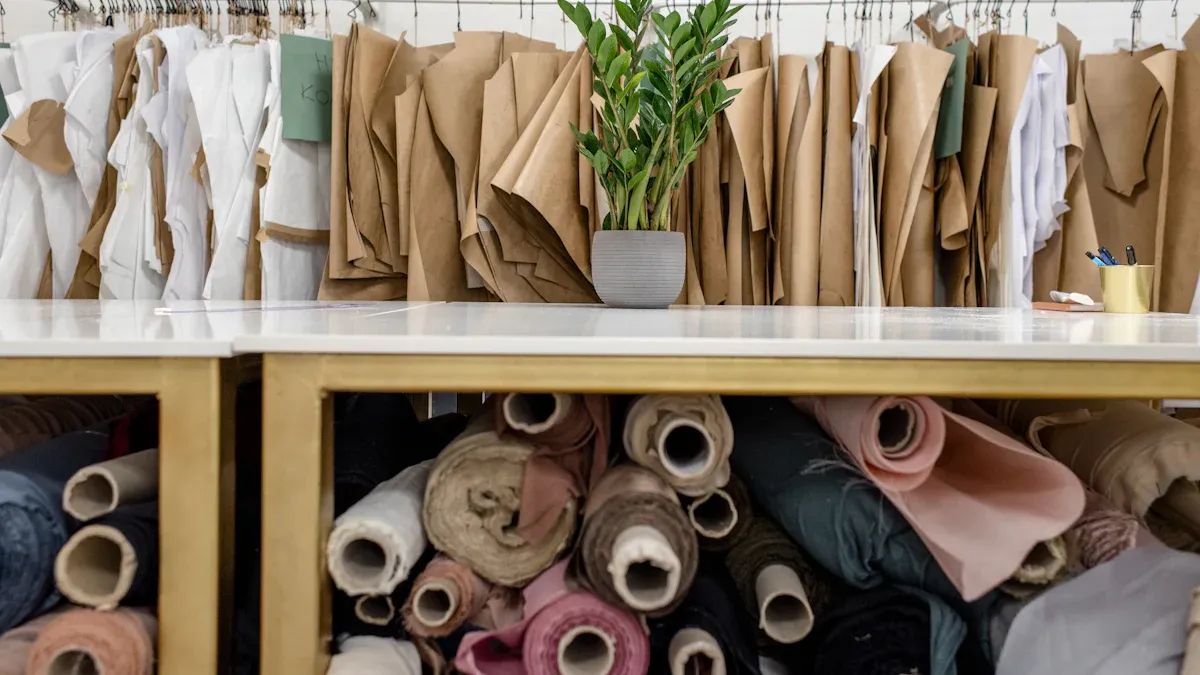
When you look for the right rib knit fabric, you find many options. The most common types of ribbing knit fabric include cotton, polyester, rayon, wool, bamboo, and specialty blends. Each type has unique qualities that affect how your clothes feel, stretch, and last. You also need to think about fabric weight and rib width. Lighter fabrics with narrow ribs, like 1×1 rib, feel soft and stretchy. Heavier fabrics with wider ribs, such as 2×1 rib or 2×2 rib, give more structure and warmth. Designers use these differences to match fabric to the right garment, from cuffs and collars to sweaters and dresses.
Cotton Rib Knit
You often see cotton rib knit in t-shirts, tank tops, and baby clothes. This fabric feels soft and lets your skin breathe. The raised vertical lines in cotton rib give it a gentle texture. You get good stretch, especially with 1×1 rib and 2×1 rib patterns. Cotton rib knit can shrink after the first wash, so you should check care labels and wash gently. Lighter and thinner cotton rib knits breathe better, making them great for warm weather. Heavier versions work well for sweaters and outerwear.
Cotton rib knit stands out for its sustainability. Organic cotton uses less water and avoids harmful chemicals. Certifications like GOTS and OEKO-TEX show you that the fabric meets strict safety standards. Cotton rib also supports upcycling. You can unravel and reuse cotton yarn, which helps reduce waste. This makes cotton rib knit a smart choice if you care about the environment.
Tip: Choose organic cotton rib knit for soft, breathable, and eco-friendly clothing.
Polyester Rib Knit
Polyester rib knit gives you strong, long-lasting clothes. This fabric resists tearing and abrasion, so it works well for activewear and uniforms. You get excellent moisture-wicking and quick-drying features. Polyester rib knit keeps you comfortable during sports or outdoor activities. The 1×1 rib and 2×1 rib patterns in polyester rib knit offer smooth surfaces and high stretch, perfect for cuffs and collars.
Polyester rib knit holds color well. Even after many washes, the colors stay bright. You should know that polyester rib knit can pill over time, especially if you do not wash it gently. Some blends add spandex rib for extra stretch and recovery. These blends, like 96% polyester with 4% spandex rib, make the fabric even more flexible and durable.
| Advantages | Disadvantages |
|---|---|
| High stretch and comfort | Prone to pilling |
| Breathable and moisture-wicking | May lose shape if overstretched |
| Durable and colorfast | Needs gentle washing |
Rayon Rib Knit
Rayon rib knit feels silky and light. You notice how it drapes softly and follows your body’s shape. This fabric works well for dresses, skirts, and tops that need a smooth, flowing look. The 1×1 rib and 2×1 rib patterns in rayon rib knit give you a soft touch and gentle stretch. You get comfort and style in one fabric.
Rayon rib knit breathes well and stretches easily. You feel cool and comfortable, even in warm weather. You should handle rayon rib knit with care. Use mild detergent and avoid bleach. Air dry your clothes to keep their shape. Rayon rib knit may shrink if you wash it in hot water or use a dryer. Pre-washing helps prevent surprises.
- Lightweight and silky
- Beautiful drape and flattering fit
- Good stretch and recovery
- Needs gentle care and air drying
Wool Rib Knit
Wool rib knit keeps you warm in cold weather. You find this fabric in sweaters, hats, and scarves. The ribbed structure, especially in 2×1 rib and 1×1 rib, gives you excellent stretch and recovery. Wool rib knit traps air, which helps insulate your body and keep you cozy.
You also get good moisture management. Wool rib knit absorbs sweat and lets it evaporate, so you stay dry. The open structure of rib knits helps move moisture away from your skin. Wool rib knit feels soft and flexible, but you should wash it gently to avoid shrinking or felting.
Note: Wool rib knit is perfect for winter clothes that need warmth, stretch, and comfort.
Bamboo Rib Knit
Bamboo rib knit offers you a soft, breathable, and eco-friendly choice. This fabric feels gentle on your skin and works well for people with allergies or sensitive skin. Bamboo rib knit is hypoallergenic and antibacterial, so your clothes stay fresh longer. The 1×1 rib and 2×1 rib patterns in bamboo rib knit give you a smooth, stretchy fabric that moves with you.
Bamboo grows quickly and needs little water or pesticides. This makes bamboo rib knit a sustainable option. The fabric is biodegradable, so it breaks down naturally after use. You also get moisture-wicking and thermoregulating benefits. Bamboo rib knit keeps you cool in summer and warm in winter.
- Hypoallergenic and antibacterial
- Soft, breathable, and moisture-wicking
- Sustainable and biodegradable
- Great for sensitive skin and eco-conscious shoppers
Specialty Rib Knits
Specialty rib knits include baby rib, tubular rib, and spandex rib blends. Baby rib uses a fine 1×1 rib pattern, making it soft and stretchy for baby clothes and fitted tops. Tubular rib knits come in a seamless tube, which you can cut for waistbands or cuffs without seams. Spandex rib blends add 2-5% spandex rib to cotton, polyester, or rayon bases. This gives you four-way stretch and excellent recovery.
You find 2×1 rib and 1×1 rib patterns in many specialty rib knits. These fabrics snap back to shape after stretching, making them ideal for cuffs, neckbands, leggings, and activewear. Spandex rib blends, like 95% cotton with 5% spandex rib or 92% polyester with 8% spandex rib, offer super stretch and a snug fit. Designers use specialty rib knits for both subtle and bold looks, depending on rib width and fabric weight.
- Baby rib: fine, soft, and stretchy (1×1 rib)
- Tubular rib: seamless, great for waistbands and cuffs
- Spandex rib: extra stretch and recovery, perfect for fitted garments
- 2×1 rib: common in specialty blends for added structure and stretch
Tip: Choose spandex rib blends for clothes that need to stretch and keep their shape, like leggings, sportswear, and fitted tops.
How Weight and Rib Width Affect Use and Feel
- 1×1 rib gives you high stretch and a smooth surface, ideal for cuffs, collars, and fitted tops.
- 2×1 rib and 2×2 rib create chunkier textures, perfect for waistbands, sweater hems, and structured garments.
- Medium to heavy weights (180-190 GSM) add durability and help clothes keep their shape.
- Lighter weights feel softer and breathe better, making them great for summer wear.
- Designers use rib width and weight to match fabric to the right garment, from subtle, fitted pieces to bold, textured sweaters.
Choosing the Right Rib Knit Fabric
Selecting the Best Rib Knit Fabric Based on Different Garment Types
You want your clothes to look good and feel right. The best way to choose rib knit fabric is to match the fabric type and weight to the garment you plan to make. Each type of rib knit fabric works best for certain clothing items. You can use the table below to help you decide:
| Rib Knit Stitch Pattern | Fabric Weight | Suitable Garment Types | Key Functional Properties |
|---|---|---|---|
| 1×1 Rib Knit | Lightweight to Medium | Cuffs, Neckbands, Hems | Excellent elasticity, shape retention, prevents sagging |
| 2×1 Rib Knit | Medium | Waistbands, Neckbands, Cuffs | Wider center rib, good stretch and recovery |
| 2×2 Rib Knit | Medium to Heavyweight | Hats, Sweaters, Scarves | Classic look, warmth, insulation |
| 4×2 Rib Knit | Medium | Dresses, Tops, Skirts | Soft, flowy drape |
| 4×4 Rib Knit | Medium to Heavyweight | Cuffs, Collars, Waistbands | Balanced stretch, textured fabric |
| Lightweight Rib Knit | Lightweight | Layering garments, Delicate tops | Gentle drape, flexibility |
| Medium to Heavyweight | Medium to Heavyweight | Sweaters, Cardigans, Outerwear | Warmth, insulation, durability |
You can also use these tips to match fabric to your project:
- Cotton rib knit gives you a soft, breathable, and comfortable fit. It works well for cuffs, waistbands, and casual wear.
- Polyester rib knit is strong and wrinkle-resistant. You get great stretch and recovery, which makes it perfect for activewear and sportswear.
- Rayon rib knit feels light and silky. It drapes well, so you can use it for dresses and skirts. Remember to pre-wash rayon to avoid shrinkage.
- Wool rib knit keeps you warm and cozy. It is best for sweaters and winter clothes.
- Bamboo rib knit is soft, eco-friendly, and hypoallergenic. It works well for activewear and sportswear because it wicks moisture and keeps you fresh.
Tip: Use 1×1 rib knit for neckbands and cuffs. This pattern gives you the best stretch and shape retention, so your clothes do not sag.
When you pick rib knit fabric, think about the weight. Lightweight ribbed fabrics work best for layering pieces and delicate tops. Medium to heavyweight ribbed fabrics give you warmth and durability, which you need for sweaters and outerwear. If you want a fabric that stretches and snaps back, look for blends with spandex or elastane. These blends give you better stretch and recovery, which is important for activewear and sportswear.
Some common mistakes can happen when you choose rib knit fabric:
- Picking a fabric that is too soft and stretchy for structured garments like jackets or pants.
- Ignoring the direction of stretch. Leggings and fitted tops need fabric that stretches both ways.
- Using fabric that is too thin for tight-fitting clothes. This can make the garment see-through or cause it to lose its shape.
- Choosing stiff or non-stretchy labels. These can cause puckering and discomfort. Always use labels that stretch with the fabric, like heat transfer or soft woven labels.
Choosing the Best Rib Knit Fabric Based on Comfort and Care Needs
You want your clothes to feel good and last long. Rib knit fabric gives you softness, stretch, and breathability. You can wear it for t-shirts, sweaters, undergarments, and more. Each type of rib knit fabric has different care needs. You should always check the care label before washing.
Follow these best practices to keep your rib knit garments in top shape:
- Wash rib knit fabrics in cold water. Use a gentle machine cycle or wash by hand. This helps prevent shrinking and damage.
- Air dry your clothes flat. This keeps the shape and elasticity. Avoid using a dryer, because heat can shrink and weaken the fabric.
- Ironing is not usually needed. If you must iron, use low heat and a protective cloth.
- Store rib knit garments folded or rolled. Hanging can stretch them out. If you hang them, use padded hangers to spread the weight.
- Reshape your clothes while they are damp. You can gently remove pilling with a fabric shaver.
Rib knit fabrics, especially 1×1 rib, stretch more than other knit types. You get more stretch in the direction of the rows. This makes rib knit fabric perfect for clothes that need to move with you, like activewear and sportswear. The fabric also bounces back well, so your clothes keep their fit after many wears.
Note: If you want a fabric that offers versatility, comfort, and easy care, rib knit fabric is a smart choice for your wardrobe.
You have many rib knit options, each with unique strengths. Thinner 1×1 ribbing works well for T-shirts and offers good stretch. Thicker 2×2 or 3×3 ribbing adds strength for sweaters and sportswear. Rib knits help your clothes keep their shape and feel comfortable. To choose the best fabric:
- Match rib type and weight to your garment’s needs.
- Check stretch and recovery by gently pulling the fabric.
- Read labels or request swatches before buying.
The right rib knit fabric keeps you comfortable and helps your clothes last longer.
FAQ
What is the best way to cut rib knit fabric?
You should use sharp fabric scissors or a rotary cutter. Place the fabric flat and smooth out any wrinkles. Cut along the grain to keep the ribs straight. This helps your garment keep its shape.
How do I prevent rib knit fabric from stretching out while sewing?
Use a walking foot or a stretch needle on your sewing machine. Pin the fabric before sewing. Do not pull or stretch the fabric as you sew. This keeps the seams even and prevents distortion.
Can I use rib knit fabric for all types of clothing?
You can use rib knit fabric for many garments like t-shirts, sweaters, cuffs, and waistbands. Rib knit works best for clothes that need stretch and comfort. Avoid using it for structured items like blazers or pants.
What tips help with sewing with rib knits?
Choose a stretch stitch or a zigzag stitch. Test your stitch on a scrap piece first. Use polyester thread for strength. Always let the fabric relax before sewing with rib knits to avoid puckering.
How should I care for rib knit garments?
Wash rib knit clothes in cold water on a gentle cycle. Lay them flat to dry. Avoid hanging, as this can stretch the fabric. If needed, use a fabric shaver to remove pills and keep your clothes looking new.

